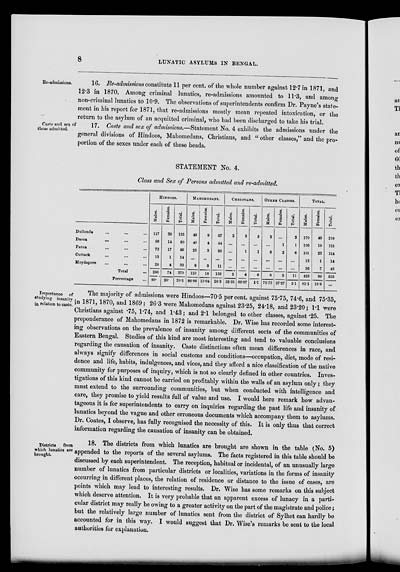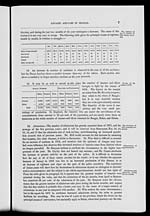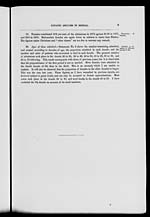Medicine - Mental health > 1867-1924 - Annual report of the insane asylums in Bengal > Insane asylums in Bengal annual reports 1867-1875 > Annual report on the insane asylums in Bengal for the year 1872
(520) Page 8
Download files
Individual page:
Thumbnail gallery: Grid view | List view

8 LUNATIC ASYLUMS IN BENGAL.
Re-admissions.
16. Re-admissions constitute 11 per cent. of the whole number against 12.7 in 1871, and
12.3 in 1870. Among criminal lunatics, re-admissions amounted to 11.3, and among
non-criminal lunatics to 10.9. The observations of superintendents confirm Dr. Payne's state-
ment in his report for 1871, that re-admissions mostly mean repeated intoxication, or the
return to the asylum of an acquitted criminal, who had been discharged to take his trial.
Caste and sex of
those admitted.
17. Caste and sex of admissions.—Statement No. 4 exhibits the admissions under the
general divisions of Hindoos, Mahomedans, Christians, and " other classes," and the pro-
portion of the sexes under each of these heads.
STATEMENT No. 4.
Class and Sex of Persons admitted and re-admitted.
|
HINDOOS. |
MAHOMEDANS. |
CHRISTIANS. |
OTHER CLASSES. |
TOTAL. |
|||||||||||
|
Males. |
Females. |
Total. |
Males. |
Females. |
Total. |
Males. |
Females. |
Total. |
Males. |
Females. |
Total. |
Males. |
Females. |
Total. |
|
|
Dullunda ... ... ... |
117 |
38 |
155 |
49 |
8 |
57 |
2 |
3 |
5 |
2 |
... |
2 |
170 |
49 |
219 |
|
Dacca ... ... ... |
66 |
14 |
80 |
40 |
4 |
44 |
... |
... |
... |
... |
1 |
1 |
106 |
19 |
125 |
|
Patna ... ... ... |
72 |
17 |
89 |
23 |
3 |
26 |
... |
1 |
1 |
6 |
2 |
8 |
101 |
23 |
124 |
|
Cuttack ... ... ... |
13 |
1 |
14 |
... |
... |
... |
... |
... |
... |
... |
... |
... |
13 |
1 |
14 |
|
Moydapore ... ... ... |
28 |
4 |
32 |
8 |
3 |
11 |
... |
... |
... |
... |
... |
... |
36 |
7 |
43 |
|
Total ... |
296 |
74 |
370 |
120 |
18 |
138 |
2 |
4 |
6 |
8 |
3 |
11 |
426 |
99 |
525 |
|
Percentage ... |
80. |
20. |
70.5 |
86.96 |
13.04 |
26.3 |
33.33 |
66.67 |
1.1 |
72.73 |
27.27 |
2.1 |
81.1 |
18.9 |
... |
Importance of
studying insanity
in relation to caste.
The majority of admissions were Hindoos—70.5 per cent. against 75.75, 74.6, and 75.35,
in 1871, 1870, and 1869 ; 26.3 were Mahomedans against 23.25, 24.18, and 23.20 ; 1.1 were
Christians against .75, 1.74, and 1.43; and 2.1 belonged to other classes, against .25. The
preponderance of Mahomedans in 1872 is remarkable. Dr. Wise has recorded some interest-
ing observations on the prevalence of insanity among different sects of the communities of
Eastern Bengal. Studies of this kind are most interesting and tend to valuable conclusions
regarding the causation of insanity. Caste distinctions often mean differences in race, and
always signify differences in social customs and conditions—occupation, diet, mode of resi-
dence and life, habits, indulgences, and vices, and they afford a nice classification of the native
community for purposes of inquiry, which is not so clearly defined in other countries. Inves-
tigations of this kind cannot be carried on profitably within the walls of an asylum only; they
must extend to the surrounding communities, but when conducted with intelligence and
care, they promise to yield results full of value and use. I would here remark how advan-
tageous it is for superintendents to carry on inquiries regarding the past life and insanity of
lunatics beyond the vague and other erroneous documents which accompany them to asylums.
Dr. Coates, I observe, has fully recognised the necessity of this. It is only thus that correct
information regarding the causation of insanity can be obtained.
Districts from
which lunatics are
brought.
18. The districts from which lunatics are brought are shown in the table (No. 5)
appended to the reports of the several asylums. The facts registered in this table should be
discussed by each superintendent. The reception, habitual or incidental, of an unusually large
number of lunatics from particular districts or localities, variations in the forms of insanity
occurring in different places, the relation of residence or distance to the issue of cases, are
points which may lead to interesting results. Dr. Wise has some remarks on this subject
which deserve attention. It is very probable that an apparent excess of lunacy in a parti-
cular district may really be owing to a greater activity on the part of the magistrate and police;
but the relatively large number of lunatics sent from the district of Sylhet can hardly be
accounted for in this way. I would suggest that Dr. Wise's remarks be sent to the local
authorities for explanation.
Set display mode to: Large image | Zoom image | Transcription
Images and transcriptions on this page, including medium image downloads, may be used under the Creative Commons Attribution 4.0 International Licence unless otherwise stated. ![]()
| Permanent URL | https://digital.nls.uk/83379560 |
|---|




